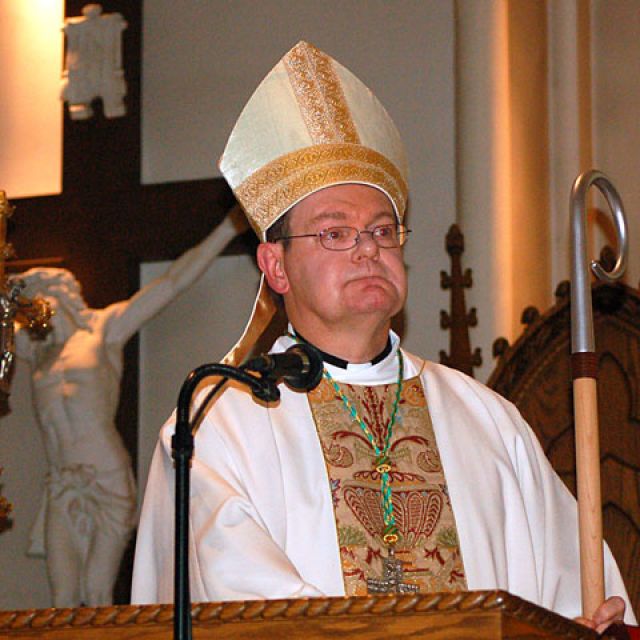ST. CATHARINES, ONT. — During Bishop Wayne Kirkpatrick's July 25 ordination, significant figures in his life raced through his mind.
"I was thinking of my parents," he told The Catholic Register, after becoming the newest auxiliary bishop of the archdiocese of Toronto. "I was thinking of Bishop Thomas Fulton who ordained me."
He was also thinking about the years he spent at the Cathedral of St. Catherine of Alexandria in St. Catharines, where the ordination took place.
"I've been here for 14 years altogether and I was ordained here."
Kirkpatrick said his new ministry is going to be a greater responsibility.
"Definitely in the laying on of hands, I could feel that responsibility coming upon me."
Born in St. Catharines on June 5, 1957, Kirkpatrick studied at St. Jerome's College at the University of Waterloo, earning a bachelor of arts in philosophy before entering St. Augustine's Seminary in 1980 where he completed a masters of divinity before being ordained to the priesthood in 1984. He also studied at Saint Paul University in Ottawa, where he earned a Licentiate (masters) of canon law in 1990.
The move to the archdiocese of Toronto is going to be difficult, Kirkpatrick acknowledged.
"It's always difficult to uproot but I think life is a series of uprootings," said Kirkpatrick. "This is a big one but certainly one that with the prayers and support of the people of St. Catharines and Toronto, I'll be able to make that."
As auxiliary bishop, Kirkpatrick will oversee care of the pastoral needs of the northern pastoral region of the archdiocese of Toronto. He has also been appointed as episcopal vicar for religious institutes of men and women in the archdiocese and episcopal vicar for the francophone community. As well, he is now titular bishop of Aradi.
St. Catharines' Bishop Gerard Bergie called the ceremony both beautiful and moving.
"I can't help but feel pride, not a sinful pride, but pride in that the diocese has provided a wonderful ceremony and provided a wonderful priest to the archdiocese of Toronto," said Bergie.
Kirkpatrick will be greatly missed, said Bergie, who has worked with the new bishop since arriving in the diocese in November 2010.
"We started in the seminary together so I've known him for many years. When I was new to the diocese, he was a great help to me and always there for me, very supportive, very knowledgable, so I'll always be indebted.
"Truly, Toronto's gain is our loss," he added.
Laurier LePage, a senior server at the Cathedral for the past 28 years, grew up in the same area in St. Catharines as Kirkpatrick and the two were schoolmates.
"As he became a priest in St. Catharines, I started to see him again… I was glad to see him come back. It was great. It was like old times together again."
Deborah LePage, Laurier's wife, lived two houses down from the Kirkpatricks.
"From seeing him play cowboys and Indians in the backyard, then to a priest, then to a monsignor and now, this is unreal. It's really unreal.
"It just makes my heart throb," she said. "I was in tears."
Thomas Brown, 40, a parishioner at the Cathedral of St. Catherine of Alexandria, has known Kirkpatrick for about 15 years.
"I'm just so happy for him to become a bishop," he said, adding that he'll miss him very much.
During the homily, Cardinal Thomas Collins said people's lives are touched by the ministry of an apostle of the Lord.
"As bishops, we need to work hard to be spiritually fruitful," he told the packed cathedral.
Mentioning courageous saints such as Francis de Sales, Charles Borromeo and John Fisher, Collins described various challenges they faced such as evangelizing a society that had fallen away from the faith.
"The challenge is great but we have mighty heroes," he said.
The episcopal motto chosen by Kirkpatrick is "Abide in me," said Collins.
"And these words guide all of us as disciples," he said.
After the ordination, Kirkpatrick was absorbing the events of the day, which took place on the feast of St. James.
"I'm the kind of person that reflects upon all that's taken place so as the day wears on and tomorrow I'll be thinking more about what's taken place."
Investiture with ring, miter and pastoral staff
The Ring
The first insignia to be received by the bishop during the rites of ordination is the ring. Upon handing over to the newly ordained bishop the ring, the principal ordaining bishop says, "Take this ring, the seal of your fidelity. With faith and love, protect the bride of God, His holy Church." The ring symbolizes discretion, since rings were used to seal private documents and the ring represents the symbolic marriage between the bishop and the Church.
The Miter
The next insignia which is given to the newly ordained bishop during the rites of ordination is the miter. The miter is a headdress which points upwards towards heaven. It is a mark of the bishops' office and a symbol of their authority.
The Crozier (also called the pastoral staff)
The last symbol given to the newly ordained bishop is the crozier. The principal ordaining bishop says, "Take this staff as a sign of your pastoral office: Keep watch over the whole flock in which the Holy Spirit has appointed you to shepherd the Church of God." Each bishop is a symbol of Christ the Good Shepherd. The crozier also symbolizes the responsibility that the bishop has in leading all to Christ.


